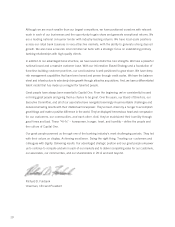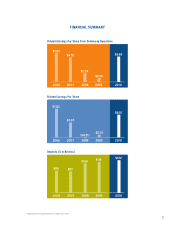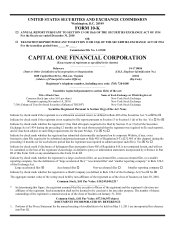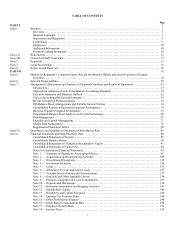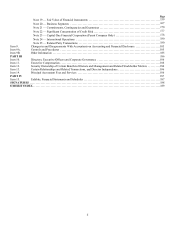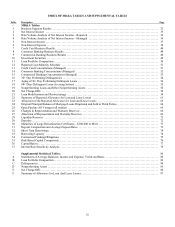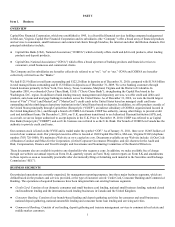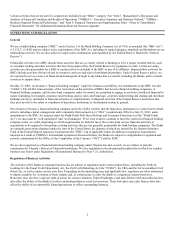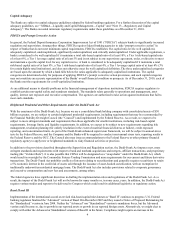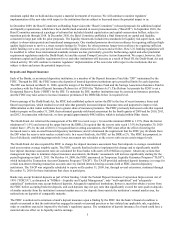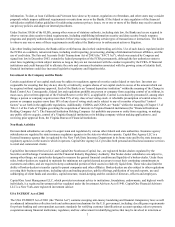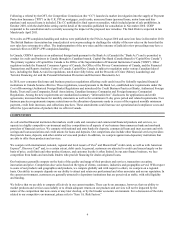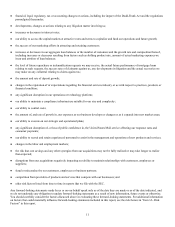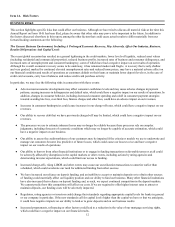Capital One 2010 Annual Report Download - page 22
Download and view the complete annual report
Please find page 22 of the 2010 Capital One annual report below. You can navigate through the pages in the report by either clicking on the pages listed below, or by using the keyword search tool below to find specific information within the annual report.
2
Certain activities that are not part of a segment are included in our “Other” category. See “Item 7. Management’s Discussion and
Analysis of Financial Condition and Results of Operations (“MD&A”)—Executive Summary and Business Outlook,” “MD&A—
Business Segment Financial Performance” and “Item 8. Financial Statement and Supplementary Data—Notes to Consolidated
Financial Statements” for additional information about our business segments.
SUPERVISION AND REGULATION
General
We are a bank holding company (“BHC”) under Section 3 of the Bank Holding Company Act of 1956, as amended (the “BHC Act”)
(12 U.S.C. § 1842) and are subject to the requirements of the BHC Act, including its capital adequacy standards and limitations on our
nonbanking activities. We are also subject to supervision, examination and regulation by the Federal Reserve Board (the “Federal
Reserve”).
Permissible activities for a BHC include those activities that are so closely related to banking as to be a proper incident thereto, such
as consumer lending and other activities that have been approved by the Federal Reserve by regulation or order. Certain servicing
activities are also permissible for a BHC if conducted for or on behalf of the BHC or any of its affiliates. Impermissible activities for
BHCs include activities that are related to commerce such as retail sales of nonfinancial products. Under Federal Reserve policy, we
are expected to act as a source of financial and managerial strength to any banks that we control, including the Banks, and to commit
resources to support them.
On May 27, 2005, we became a “financial holding company” under the Gramm-Leach-Bliley Act amendments to the BHC Act (the
“GLBA”). The GLBA removed many of the restrictions on the activities of BHCs that become financial holding companies. A
financial holding company, and the non-bank companies under its control, are permitted to engage in activities considered financial in
nature (including, for example, insurance underwriting, agency sales and brokerage, securities underwriting and dealing and merchant
banking activities), incidental to financial activities or complementary to financial activities if the Federal Reserve determines that
they pose no risk to the safety or soundness of depository institutions or the financial system in general.
Our election to become a financial holding company under the GLBA certifies that the depository institutions we control meet certain
criteria, including capital, management and Community Reinvestment Act (“CRA”) requirements. Effective July 21, 2011, under
amendments to the BHC Act enacted under the Dodd-Frank Wall Street Reform and Consumer Protection Act (the “Dodd-Frank
Act”), we also must be “well capitalized” and “well managed.” If we were to fail to continue to meet the criteria for financial holding
company status, we could, depending on which requirements we failed to meet, face restrictions on new financial activities or
acquisitions or be required to discontinue existing activities that are not generally permissible for bank holding companies. The Banks
are national associations chartered under the laws of the United States, the deposits of which are insured by the Deposit Insurance
Fund of the Federal Deposit Insurance Corporation (the “FDIC”) up to applicable limits. In addition to regulatory requirements
imposed as a result of COBNA’s international operations (discussed below), the Banks are subject to comprehensive regulation and
periodic examination by the Office of the Comptroller of the Currency (“OCC”) and the FDIC.
We are also registered as a financial institution holding company under Virginia law and, as such, we are subject to periodic
examination by Virginia’s Bureau of Financial Institutions. We face regulation in the international jurisdictions in which we conduct
business (see below under Regulation of International Business by Non–U.S. Authorities).
Regulation of Business Activities
The activities of the Banks as consumer lenders also are subject to regulation under various federal laws, including the Truth-in-
Lending Act, the Equal Credit Opportunity Act, the Fair Credit Reporting Act (the “FCRA”), the CRA and the Servicemembers Civil
Relief Act, as well as under various state laws. Depending on the underlying issue and applicable law, regulators are often authorized
to impose penalties for violations of these statutes and, in certain cases, to order the Banks to compensate injured borrowers.
Borrowers may also have a private right of action for certain violations. Federal bankruptcy and state debtor relief and collection laws
also affect the ability of the Banks to collect outstanding balances owed by borrowers. These laws plus state sales finance laws also
affect the ability of our automobile financing business to collect outstanding balances.


